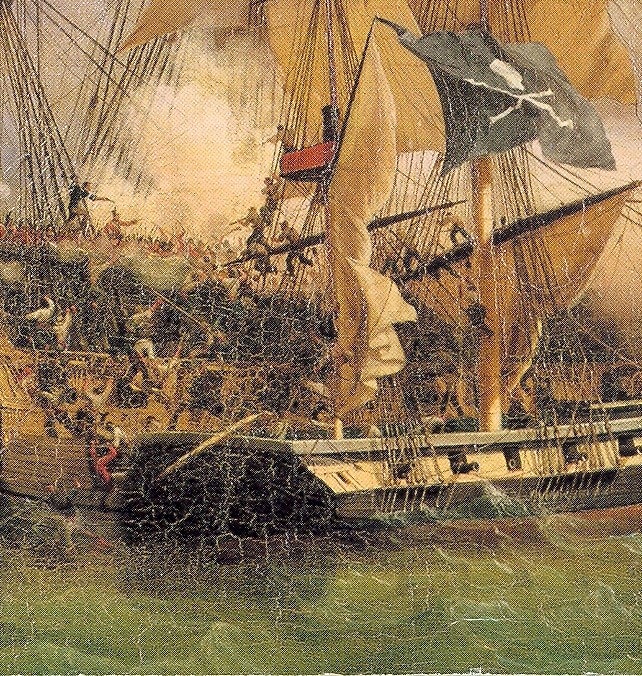Ben Merriman presents a selection of piracy cases from the proceedings of London's Old Bailey. Although a few live up to the swashbuckling heists of stereotype, many reveal the surprisingly everyday nature of the maritime crimes brought before the court, including cases involving an argument over chickens and the stealing of a captain's hats.

Painting by Ambroise-Louis Garneray, circa early 1800s, showing a pirate ship boarding a merchant vessel - Source.
For centuries, the Old Bailey was the city of London’s main criminal court. Printed accounts of some 200,000 trials—the Proceedings—were published from 1674 to 1913. The Proceedings describe ordinary people in mostly ordinary legal trouble: three-fourths of the defendants were in the dock for theft, and on the whole the trials deal with mundane affairs. However, the Old Bailey also held jurisdiction over many cases of maritime piracy. These cases stand out from the many trials dealing with occurrences in and around London.*The Dove was at anchor off the port of Leghorn when EDWARD JOHNSON stabbed Captain Benjamin Hawes with a small blade, puncturing the Captain's heart. The Captain's apprentice, Walker, discovered Hawes dead in his cabin. He ran up to the deck to inform the first mate, only to find the mate and crew preparing to sail immediately, for they were all part of a plot to seize the ship. Walker jumped overboard and swam to a group of nearby vessels, whose crews stormed the Dove before it could sail away. The crew had conspired to make off with the ship because it belonged to Jews, from whom it was no sin to steal.
*
GEORGE GEERY took to the sea at an early age, and being a man of bad reputation, assumed the surname Wood, after a dead friend who was widely renowned for honesty. Geery, alias Wood, made sail on the Black Prince, which plundered ships throughout the Atlantic until it ran aground on Hispaniola during a storm. There the crew obtained false passports and sailed to Portugal, where Geery deserted with a confederate. He did not hang for his service on the Black Prince, but for a later transgression: illegally boarding the Derge Sustures and stealing several of the captain's hats.
*The steamship Lion sailed from London to the port of Harlingen, in the Netherlands. As the ship was preparing to return to England, Captain Henry William Neville saw a number of fowls being brought on board. On inquiring, Captain Neville learned that the fowls had been bought by first engineer JOHN JENNINGS SMITH, who planned to take them back to England at no charge. When the Captain informed Smith that he would need to pay the usual shipping rate for his fowls, Smith shouted to the rest of the crew to stop the fires and halt preparations to sail, which they did readily. Neither the first mate, the company shipping agent, a gentleman of the city of Harlingen, nor the British consul could prevail upon Smith and his eight co-conspirators to return to the ship, which returned to London three days later with a replacement crew. At trial, however, it came to the attention of the court that the first mate had not filed proper contracts before the Lion sailed; the nine were therefore not mariners in the eyes of the law, and were immediately acquitted.*
The St. John Pink had left Padras laden with grain. Soon after setting out two of the apprentices heard a commotion in the night: Captain Benjamin Hartley was being attacked by his crew. After his blunderbuss misfired, RICHARD COYLE, a mariner, attempted to throw the Captain from the ship, but Hartley held to the lanyards. Coyle then beat the Captain, dangling from the side, with a small shovel, which proved ineffective. JOHN RICHARDSON, a carpenter, struck the Captain in the head with an axe, after which the Captain fell into the sea and died. The ship, now under the command of Coyle, sailed for Malta, but did not land, for the apprentices would not agree to unite under the mutineers. Later the St. John Pink neared Foviano, where Coyle, wearing the dead Captain's uniform, sought to buy liquor. Nobody would sell. That night the apprentices, who had been imprisoned below, escaped. They took a boat ashore to alert the local authorities. Coyle fled the St. John Pink in a long boat, but was apprehended in Tunisia. At trial he produced witnesses to attest to his character, but one scarcely remembered him, and the other recalled that Coyle had once drilled holes through the side of a ship........MUCH MORE